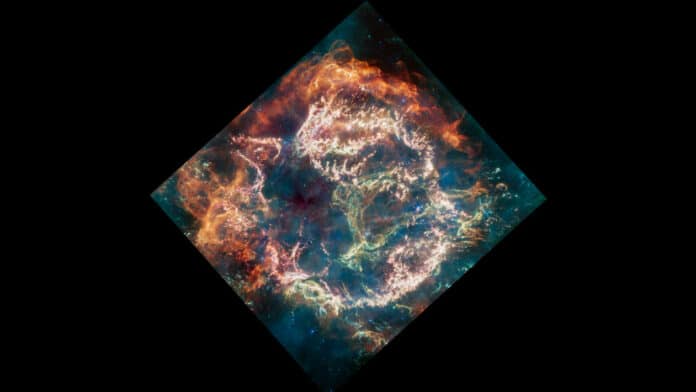James Webb Space Telescope has granted earthbound scientists a new near-infrared, detailed image of Cassiopeia A (Cas A). Cas A is the youngest known stellar remnant from an exploding, massive star in our galaxy, which makes it a unique opportunity to learn more about how such supernovae occur.
The remnant sits in the region of the sky that is thought to belong to the constellation Cassiopeia, and it is roughly 11,000 light-years from Earth. Cas A, composed of five bright stars arranged in the shape of a “W,” is invisible to human eyes from Earth but is located in the area that appears to be off to the right of the W’s last stroke.
Danny Milisavljevic, assistant professor of physics and astronomy at Purdue University’s College of Science, said, “I have spent 17 years studying stars and their titanic explosions. I’ve used dozens of telescopes – both ground- and space-based – covering the electromagnetic spectrum from gamma rays to radio wavelengths. And yet, I was still unprepared for the data that Webb provided. I am awestruck by their quality and beauty.”
“Cas A represents our best opportunity to look at the debris field of an exploded star and run a stellar autopsy to understand what type of star was there beforehand and how that star exploded.”
Scientists have investigated Cas A for many years. Similar to how infrared cameras provide humans with different information than cameras that only observe in the visible light spectrum, examining the structure using multiple wavelengths offers astronomers fresh insights into stellar anatomy.
Very fine detail can be seen in the newly acquired image from JWST’s golden honeycomb of 18 mirrors. It converts mid-infrared light into visible light, enabling researchers to study structures and small details. The star’s material collides with the surrounding gas, and dust is shown by large curtains of material colored red and orange. Bursts of pink show where the star’s composite elements, such as oxygen, argon, and neon, are blazing among those rose swaths.
The huge green loop on the right side of the image is one of the image’s most perplexing features for the experts.
Milisavljevic said, “We’ve nicknamed it the Green Monster in honor of Fenway Park in Boston. If you look closely, you’ll notice it’s pockmarked with little bubbles. The shape and complexity are unexpected and challenging to understand.”
Higher-resolution images in more wavelengths, especially the infrared, give astronomers a clearer look at the intricacies of the structure. Like picking up binoculars to help resolve the colors and patterns on a bird’s wing, the more detail scientists have, the more information they can infer and analyze.
Tea Temim, a program co-investigator from Princeton University, said, “Compared to previous infrared images, we see the incredible detail that we haven’t been able to access before.”
By studying Cas A with JWST, astronomers hope to gain a better understanding of its dust content, which can help inform our understanding of where the building blocks of planets – and ourselves – are created.
Temim said, “In Cas A, we can spatially resolve regions that have different gas compositions and look at what types of dust were formed in those regions.”
